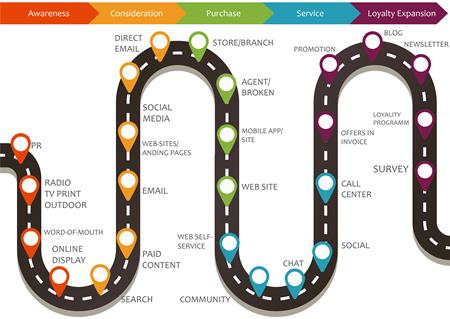
A customer journey map is a visual story explaining the process they go through when engaging with your brand. It begins with their awareness of your brand and ends with potential loyalty and even advocacy.
This kind of mapping is necessary to create seamless customer service for consumers. It’s also a means of gaining insights into what your current customers experience as they interact with your brand. If you’re looking to design your own map, there are a few key points you can make use of to get you going.
Here’s how you can get started on your customer journey mapping:
Gather All the Relevant Departments
The first step to get you started on mapping out your customer journey is to bring your team together. This involves the heads of departments in sales, marketing, customer service and web design. Each team should be relevant in promoting the customers’ relationship to your brand or organization.
It’s important to include the correct group of employees for your journey mapping to plan how customers can interact with your brand during each phase of their buying. These are the stages of customer awareness and exposure to purchasing and eventually loyalty. This collaboration of teams will help you create consistency within every service segment of the map.
Create a Customer Persona
Once you have your team assembled, you can focus on creating a customer persona. This is to gain a better understanding of your consumers and how they’re likely to approach your brand or service. The persona is meant to represent the customer’s experience and behavior as they engage with your business so you can improve it.
Keep in mind that you should create a customer persona for each stage of their purchasing. This is because your customers are likely to have different goals and functions which influence their decisions. For instance, potential buyers at the researching stage might just be trying to find out more about your products or services. Customers at the purchasing stage could be comparing different payment methods or plans to choose the best option for themselves.
Segment Customer Personas Into Touchpoints
At this point, you can start sorting your customer personas into touchpoints, which will eventually become part of your journey mapping. The main goal here is to start planning for the different times your consumers will be using your services as they move along through each buying phase.
The touchpoints should include what customers can expect before, during, and after they buy from you. You can segment the personas into stages such as:
- First Stage – awareness of your brand, which includes advertising and content
- Second Stage – researching, which includes online searches, browsing your websites, and contacting customer support for queries
- Third Stage – consideration such as when customers compare prices for choice reduction
- Fourth Stage – purchasing of your product through their preferred payment options
- Fifth Stage – feedback that can include surveys and reviews of their experience
This segmentation should give you a clearer overview of how your operations influence your customers into buying.

Compile Your Existing Data
Now, it’s time to get started on your customer journey map by using your existing data and filling it into the above touchpoints. You can group your data according to each segment such as the marketing materials that you have for the first stage. These can be online adverts, print web, and radio promotions that you currently use for example.
As you compile your data to fit into each segment, it’s essential that each department assess its current performance and customer perception. This is vital in finding the areas that need improving to better satisfy customers and lead to higher conversions. As such, if your data shows that many consumers stop at any point in their buying journey, there could be factors hindering their decision. In this case, you’ll need to identify these hesitations known as ‘pain points’ to make the buying journey easier.
Conclusion
After you’ve completed the above steps, you and your team can then start drawing up a more detailed journey map. If you’re a new business startup without previous customer experiences to draw from, you can use the map to plan every stage.
Be aware that your map should be flexible to changes you may want to implement later. This is because customer relationships and experiences can change from day to day and may need you to make adjustments. With all these elements combined, you can manage and anticipate your consumers’ movements as they participate with your brand. As your team makes refinements along the way, it can lead to more sales and brand loyalty over time.
About the Author
Cynthia J. Graves is a digital marketer and part-time freelance writer from Cumberland, Maryland. She’s passionate about digital technology and spends most of her time reading articles about the latest trends in social media. She aspires to start her own online marketing firm one day.





Cynthia, for rapidly mapping customer journeys and prototyping website structure is also good Octopus.do.